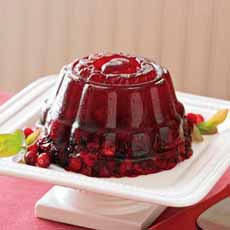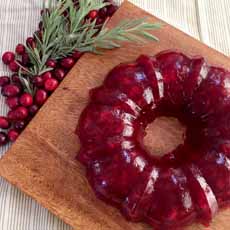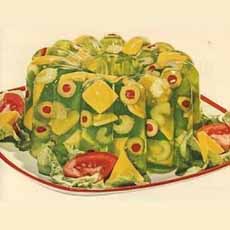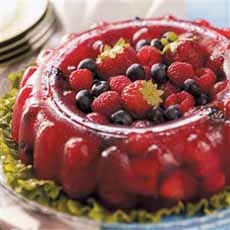TIP OF THE DAY: Cranberry Sauce Gelatin Mold
|
This retro idea from Williams Sonoma is an elegant addition to Thanksgiving and Christmas tables.
Our family was mold-centric for every special occasion: for Valentine’s Day, raspberry Jell-O with raspberries, strawberries and red grapes; for Easter, lime Jell-O with sour cream and crushed pineapple; for Independence Day, red, white and blue layers; and on and on. (Remember, this was the era of the Jell-O mold; our childhood favorite was a lemon Jell-O mold filled with fruit cocktail.) Today’s recipe is a gelatin mold, not a Jell-O mold. It uses unflavored gelatin—which is also the gelatin used to make savory aspics. Note that in addition to Thanksgiving turkey and ham, cranberry sauce/mold is great with all poultry and pork, any time. For this recipe, use any mold you have. We use an open center mold like photo #2 for Thanksgiving, and a star shape for Christmas. If you don’t have a mold, use a bundt pan or even a loaf pan. The history of the Jell-O mold is below. Prep time is 15 minutes, cook time is 30 minutes. Ingredients For 16 Servings |
 [1] A classic cranberry mold, from Williams-Sonoma.
|
|
|
Preparation 1. COMBINE the cranberries, sugar, zest, orange juice, salt and 3/4 cup plus 2 tablespoons water in a large saucepan over medium-high heat. Bring to a boil, then reduce the heat to medium-low and simmer, stirring occasionally, until the sauce thickens and the cranberries have burst, 25 to 35 minutes. Note: The sauce should measure no more than 3-3/4 cups. Meanwhile… 2. POUR the remaining 2 tablespoons of water into a bowl and sprinkle with the gelatin. Let it stand until the gelatin softens and swells, 5 to 10 minutes. 3. SPOON 3/4 cup of the hot juices from the cranberries into the gelatin and whisk until the gelatin has dissolved. If you prefer a sauce with a smoother texture, transfer the remaining cranberry mixture to a food processor and pulse for 2 seconds (10 to 15 times), then proceed as directed. 4. POUR the gelatin mixture into the cranberry mixture and whisk to combine. Lightly coat the inside of the mold with nonstick cooking spray. Pour the cranberry mixture into the prepared mold and let cool to room temperature. Cover loosely with plastic wrap and refrigerate for at least 8 hours or up to overnight. 5. TO UNMOLD: Set the mold in a large bowl of warm water (115° to 120°F) so the water reaches almost to the rim of the mold. Let stand for 30 seconds, then remove the mold from the water (retain the water in case you need it in Step 6). Carefully insert a small offset spatula or paring knife along the side of the mold. Gently pull the gelatin away from the mold to release the suction, then remove the spatula. 6. PLACE a serving platter upside down on top of the mold and invert the platter and mold together. Gently shake the mold until you hear the gelatin begin to release, then lift off the mold. If the gelatin does not release, return the mold to the warm water for 15 seconds, then repeat the Steps 5 and 6. |
||
|
[4] A Jell-O mold packed with fruit. Here’s the recipe from Taste Of Home. |
GELATIN MOLD / JELL-O MOLD HISTORY Gelatin dishes date to medieval Europe, laboriously made in the kitchens of the elite. Collagen had to be slowly rendered from animal bones, then clarified. Take out the great Bones of four Calves Feet, and put the Feet into a Pot with ten Quarts of Water, three Ounces of Hartshorn, three Ounces of Isinglass, a Nutmeg quarter’d, four Blades of Mace; then boil this till it comes to two Quarts, and strain it through a Flannel-Bag, let it stand twenty-four Hours, then scrape all the Fat from the Top very clean, then slice it, and put to it the Whites of six Eggs beaten to Froth, boil it a little, and strain it again through a Flannel-Bag, then run the Jelly into little high Glasses…You may add Orange-flower Water, or Wine and Sugar, and Lemon if you please, but this is all Fancy. (Quoted in Richard Sax, Classic Home Desserts) [source] Decorative molds, often centerpiece-size, were created to hold the gelatin or “jelly,” aspic, or similar dish. The gelatin dish was a work of art. Victorians loved molded foods of all kinds. Thomas Jefferson returned from France with a penchant for wine jelly, and his kitchen staff had been trained in France to make it. In New York high society, gelatin dishes were a delicacy. In 1845, an American inventor patented a dessert product that was set with gelatin, but it didn’t take off. Much later, in 1897, powedered, fruit-flavored gelatin was invented and this time, it took off (the history of Jell-O). Around the turn of the 20th century, many women in the emerging American middle class sought to elevate domestic science in their homes, from efficiency and cleanliness to more interesting food. Jell-O took off. |
|
|
A housewife could stretch her family’s leftovers by encasing them in plain gelatin. It was also an efficient and tidy process. Everything from vegetables to green salads to chicken salad was molded in gelatin. By 1902, Jell-O sales were beginning to soar, and in 1904, Charles Knox promoted Knox Gelatin at the World’s Fair. Smartly, he staged a cooking contest; and in 1905, Mrs. John Cooke of New Castle, Pennsylvania, won third prize in Perfection Salad, “an aspic filled with finely chopped cabbage, celery, and red pepper” that had eye-appeal with its “jewel-like and impeccable” molded precision. Meanwhile, families were enjoying snacks and desserts of fruit-flavored Jell-O, and Jell-O salads were ladies’ luncheon fare. Jell-O cookbooks appeared, some devoted entirely to lime Jell-O (source). Sugar was rationed during World War II, but when supplies were restored, recipes like Red Crest Salad—strawberry Jell-O with chopped tomatoes and pickles—became popular. And so it went, with savory and sweet gelatin molds and loves, up until the 1970s, when California cuisine and the advisory to consume less sugar made Jell-O molds out of style.
|
||





